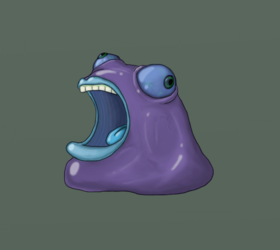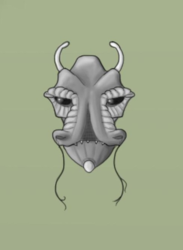Sign In
CloseA-Z Challenge word : "Bumple Beepole"
Heh, my initial ideas kept going wrong, and they evolved into this. What I intended to be a clumsy big-nosed worm that was blind and bustled around in big packs, using a honk-sounding nose-shove as a way of communicating... well, it turned into this, which is now going to be an actual species in my head-canon for Luros-B. Still not 100% on the name though. Clingworm, Fieldworm, bluh. Was originally "Lim-ba" by alien tribals which meant "False mouth". Ah well, here's the babbled details :
The Clingworm is a deceptively complex organism found in most sizeable grasslands and shores. Each is made up of a number of tentacles that end in psuedo-suckers that function as both mouths and as feet. They move by carefully tumbling towards their destination, passing the legs up and over the central chamber in a vaguely tumbleweed-like motion while keeping the body off the ground. Most of their time during the day is spent trying to lure food by gathering in large numbers, anchoring themselves to the ground, and then extending a single tentacle into the air. The cup-like sucker is then opened and stretched wide, so that the membranes become partially transparent in the sunlight, acting as a false 'flower' to attract pollinating insects, which are caught the moment they touch the membrane as the sucker snaps reflexively shut. The morsel is then swallowed down the neck towards the central chamber for digestion. Though one of their 'feet' contains a set of retractable lance-like teeth (likely the remains of a past evolutionary state), smaller scavenging fauna are only targeted when they stray too close, but they are rarely led into active pursuit.
During the night, clingworms will move a short distance to find a safe resting location until they detect sunlight again, partially burying themselves in dirt, tucking themselves into hollows or clinging like limpets from trees and rocks. Starving individuals may attempt to forage but are typically unsuccessful. Reproduction is asexual, with partially-developed juveniles being discarded in a thick, gum-like mucous. After eating the mucous and any still-dormant siblings, they gravitate towards luring sites where they feed on the waste matter of adults and any ground-based micro-fauna until large enough to lure for themselves. The survival of most juvenile clusters is very low, but the species survives by virtue of sheer numbers.
Practically blind, the Clingworm interprets the world around it mostly through tactile and olfactory sense, allowing it to locate nearby luring sites and also the presence of larger creatures as to avoid them. They do however possess a series of very limited visual organs inside each pseudo-sucker, but the mouth/foot must be open for it to detect anything, so is used mostly to detect movement at longer ranges or to react to attacks while trying to lure food. Clingworms will typically flee from nearby danger with bursts of surprising speed, but older worms will sometimes leap towards nearby threats in an effort to latch on and randomly constrict and yank at any random grip it can get. While not particularly effective against larger opposition, multiple worms can easily suffocate or maim a single target.
As their diet does not provide them with much expendable energy, they tend to be passive and non-confrontational. However the Clingworm has a moderate lifespan and a constant rate of growth, which drives it towards eventual feats of aggression when luring becomes an unsustainable method of survival. What starts as tracking the scent of mammalian breath to try snatch young creatures will eventually become an almost suicidal full-frontal attack on mature herdlings.
Submission Information
- Views:
- 497
- Comments:
- 0
- Favorites:
- 2
- Rating:
- General
- Category:
- Visual / Digital




